Becerra and Muskin Expose Wiley Fifth Graders to Engineering Via Fun Solar Projects
March 7, 2019
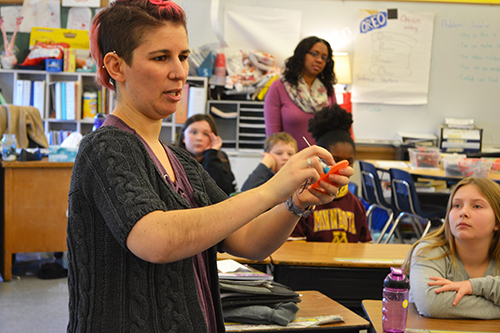
Natalie Becerra explains to the 5th grade class from Wiley Elementary School about the solar car project.
On most Tuesday mornings since the end of January, Tanissa Tutwiler's 5th grade class at Wiley Elementary has been learning some things about mechanical, electrical, even environmental engineering via some cool hands-on projects, including making a solar cell and designing a solar car. The activities were presented by a couple of Illinois staff who are passionate about STEM education: Natalie Becerra, who currently works as Extra Help for the Graduate Office in Academic Affairs, but who dreams of doing STEM outreach permanently, and Joe Muskin, the Education Coordinator of the Mechanical Science and Engineering Department.
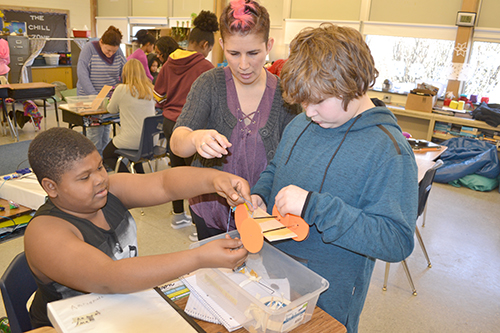
Natalie Becerra helping students build their solar car.
Becerra, who plans on visiting the classroom nine times to lead these activities, shares why she decided to do this project: “I really want to be a STEM outreach coordinator,” she admits, “so this seemed like a fun project to work on.” Becerra recalls chatting with Joe Muskin and learning about the solar car unit he’s been developing. “So I saw how it worked,” she adds, “and I thought we could bring it here.” Natalie designed the unit teaching students about solar and hybrid car technology by pulling together various activities and curricula, including the POETS-developed solar car curriculum.

Natalie Beccera helps Wiley Elementary students test their solar car.
As part of her emphasis on the environment and sustainability, for the first lesson of her project, she actually had the class making solar cells. In an activity called “Juice from Juice!” which she learned about when volunteering at Caltech, the students made dye-sensitized solar cells using blackberry juice as the light-absorbing material.
Did they work? “Yeah, they got some power out of them,” she says, “so that was exciting!”
Becerra explains why it’s good for kids to do hands-on projects like these: “I think it really teaches them to become engineers and really play with things,” she claims. “Some students learn the best by using their hands. We all learn differently, and I think the more different ways we can learn, the more we can actually grasp ideas and internalize them. I think it's good to get different pathways, listening, writing, working with your hands, kinetics.”
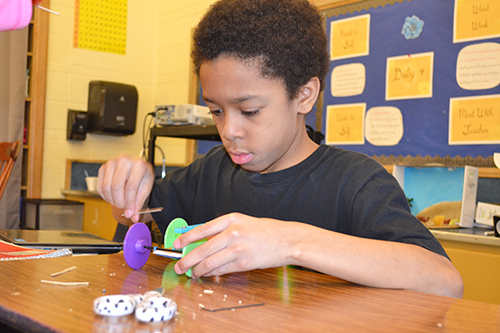
A fifth grader works on his team's solar car.
The kids weren’t the only ones who gained something through this project. Becerra discovered some aspects of the curriculum that she might want to tweak before doing the next iteration with another group of kids. For example, the solar cells project required a lot of input from her, and going from group to group. “Maybe that's not the best way to go,” she admits. “So I think a project like this where everyone gets to play around and work with things without so much input from me is more helpful and more fun for them.”
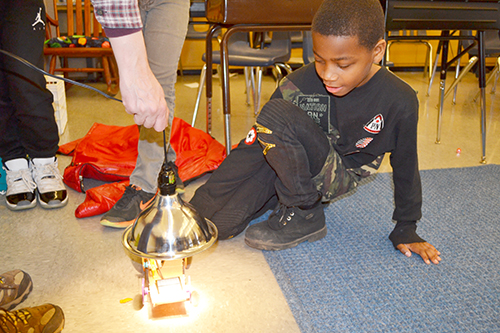
A Wiley 5th grade student tests their solar car.
So she’s planning making some adjustments. “Yeah, exactly,” she affirms, regarding changing the curriculum so the students somehow need her less next time. “That thought process is getting me to really think like a better coordinator of these projects.”
Despite the learning curve, Becerra says she found it to be quite rewarding. “I've definitely had a lot of fun,” she acknowledges, “so that's been a plus.” She also expresses her thanks to Ms. Tutwiler for allowing her to do the project with her class, and to Joe Muskin for having provided all the materials.
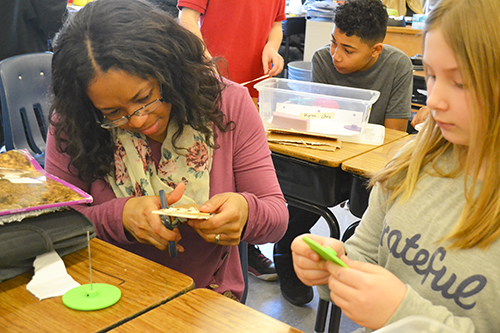
Above and below: Tanissa Tutwiler helps one of her students construct her solar car.
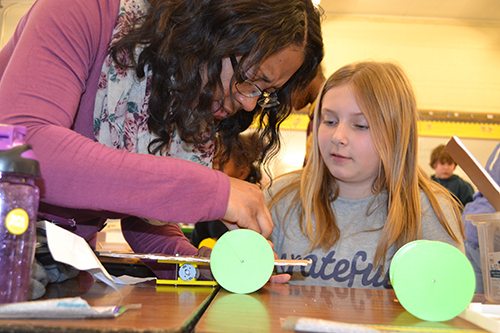
Wiley’s fifth grade teacher, Tanissa Tutwiler, shares some of the benefits of doing this project with her students. “Well, besides the fact that they're having so much stinking fun,” she exclaims, “it actually aligns with what we're doing now with science. Starting last year, we're doing a lot of inquiry-based, project-type learning, so this is allowing them to figure it out without us telling them what they have to do. It's a lot of thinking.”
Plus, she’s quite pleased that it lines up with some of the skills listed on their report card. “I totally have something to put on there for them working with a group,” she explains, as well as addressing the question, “’Were they able to think outside of the box?’ It all works out.”
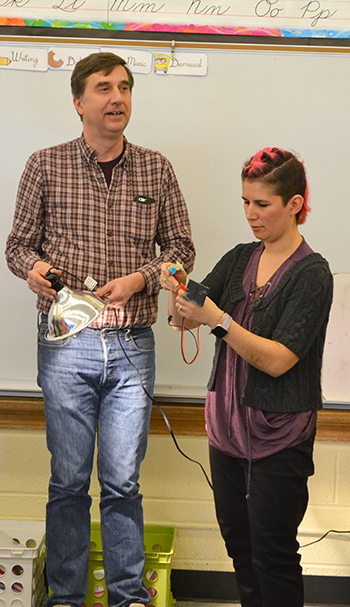
Joe Muskin (left) and Natalie Beccera explain to students how the solar panels work on the car.
So how did her students do in regards to learning teamwork and working with a group? Did they collaborate, or did one or two members of the group tend to take over?
Tutwiler indicates that most of the groups worked really well together, because this actually, wasn’t their first group project; they've done other projects, and are currently working on something else in science. Of the nine groups, she reports dealing with one group that was particularly frustrated:
“With just a little bit of a nudge and helping, they are getting somewhere,” she reports, indicating that she’s been seeing them talk about what they're going to do. “They did have a little bit of issues that were frustrating because they didn't have instructions on how to do it,” she adds, “but they started listening to each other, and I'm seeing progress.”
Regarding whether she’s seen any future engineers among her students, she reports, “Oh my goodness, absolutely!” then indicates that she’d pointed out to both Becerra and Muskin, “You need to pay attention to these two groups!”
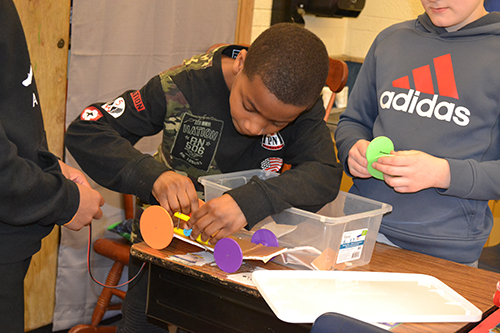
A Wiley Elementary 5th grade student constructs their solar car.
She goes on to share about the impact the project was having on a particular student: “One of my top kids, he was super excited about this because he could use all the extra stuff that we don't really do here [in class normally], and his parents are super excited about that because it is a really good thing.”
Tutwiler shares one of the benefits of bringing university people into her classroom: “More ideas!” she exclaims. “This gives me a chance to think if we can do it next year maybe, or some type of adaption of it. Plus, I've learned more.” One of the things she herself learned about was using blackberries to fuel a solar cell, along with trying to “figure out how to get that motor running—I didn't know about that either. So I'm learning too!”
Tutwiler’s take on the whole experience? “This is really cool and I'm super excited!”
Story and photographs by Elizabeth Innes, Communications Specialist, I-STEM Education Initiative.
More: 6-8 Outreach, POETS, RET, 2019
For additional articles about POETS, see:
- POETS Seeks to Change the Attitudes, Shape of Students in the STEM Pipeline
- POETS, New NSF Center at Illinois, Poised to Revolutionize Electro-Thermal Systems
- National Science Foundation Award #1449548: Engineering Research Center for Power Optimization for Electro-Thermal Systems (POETS)
- POETS website
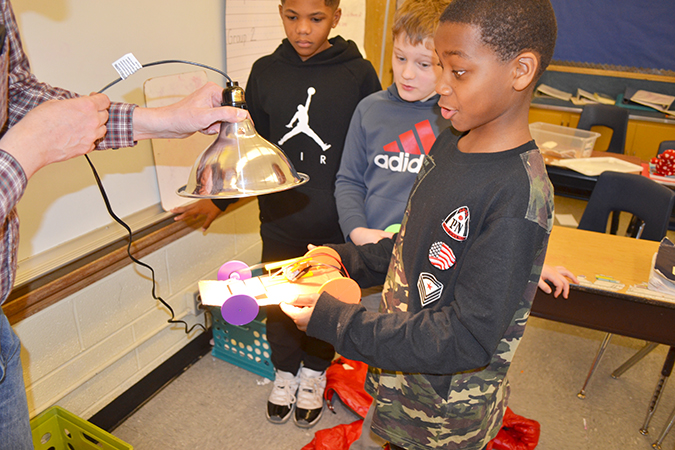
A Wiley Elementary 5th grade student tests his team's solar car.













.jpg)
















